Find out how the Fujifilm X-T20 performs by reading our full online review
Fujifilm X-T20: At a glance
- £799 body only
- 24.3-million-pixel X-Trans CMOS III sensor
- X-Processor Pro imaging engine
- 2.36-million-dot OLED viewfinder
- 3in, 1.04k-dot tilting LCD touch screen
- ISO 200-12,800 (expandable to ISO 100-51,200)
- 91-point AF system (expandable to 325-points)
- 8fps continuous shooting

The X-T20 houses a 24.3-million-pixel X-Trans CMOS III sensor behind its X-mount
Fujifilm had an incredibly busy year last year updating its X-Pro series with the X-Pro2 and the X-T series with the X-T2. The manufacturer has followed this up with a flurry of New Year announcements and key among these is the all-new X-T20 – the direct replacement for the now discontinued Fujifilm X-T10.
It slots into the X-series as a simplified, more affordable alternative to the Fujifilm X-T2 and looks virtually identical to its predecessor with a boxy, high-shouldered design. There is much more than first meets the eye and beneath its skin lie a number of improvements that are intended to give it mass market appeal with aspiring amateur and enthusiast photographers.
Features
One of the key talking points is the X-T20’s resolution, which has seen a jump from 16.3-million pixels to 24.3-million-pixels. It’s equipped with the same 24.3-million-pixel X-Trans CMOS III sensor as other current X-series models such as the X-Pro 2 and X-T2 and this provides an ISO range that runs from 200-12,800, expandable to ISO 100-51,200. The good news here is that the X-T20 no longer restricts raw format recording between ISO 200-6400 like the X-T10 and the improvements Fujifilm has made to the noise-processing algorithm are said to lower noise levels at high ISO.

Here the X-T20 is coupled to the recently announced Fujinon XF 50mm f/2 R WR
By implementing Fujifilm’s latest X-Processor Pro imaging engine, the X-T20 springs into life slightly faster (0.4secs) with a minimal shutter lag of just 0.05sec. You might think the continuous shooting speed has also increased, but it continues to rattle out a burst at 8fps with continuous autofocus during shooting – the same as the Fujifilm X-T10.
The X-T20’s autofocus system has been brought bang up to date with a larger phase detection AF area and updated algorithm delivering an ultra-fast AF speed of 0.06sec. The number of focusing points has been dramatically expanded from 49 in the X-T10 to 91 points – expandable to 325 – with the central area of 49 points using phase-detection AF pixels. There’s the usual single point and Wide/Tracking AF area modes to choose from, not forgetting Zone AF which gives you the option to select between a group of 3×3, 5×5 or 7×7 AF points.
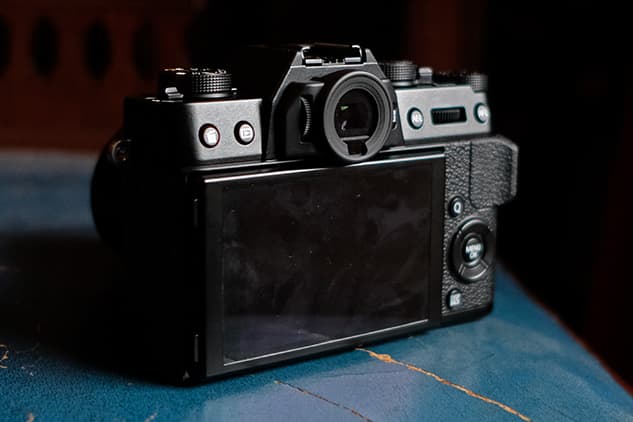
A rear view of the X-T20 showing its prominent thumb rest at the corner of the body
For the fastest focusing in Zone AF area mode, users will want to select the central 3×3 or 5×5 AF zones that work with the on-sensor phase-detection AF pixels. Added to this, the X-T20 introduces five custom AF-C modes to enhance focus tracking when shooting moving subjects, just like the ones we’ve witnessed before on the Fujifilm X-T2. Unlike its senior relative, you’re not given the option to manually adjust the tracking sensitivity, speed tracking sensitivity or zone area switching to create your own custom AF-C preset.
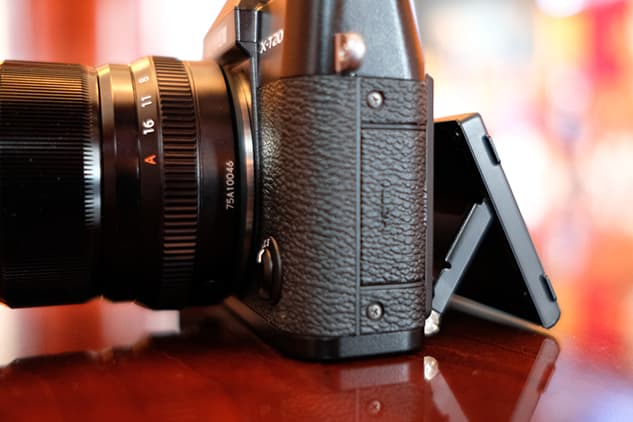
The X-T20 has a two-way tilt screen mechanism. The X-T2 features a three-way tilt mechanism
At the rear, the 3in, 1.04-million-dot screen features two-way tilt manoeuvrability and now benefits from being the touch screen type. By turning the touch screen setting on you’re given the option to control the position of the focus point or fire the shutter in shooting mode, and by using finger gestures much like you would on a Smartphone or tablet, you can view and enlarge images easily in playback mode.
The X-T20’s centrally-placed electronic viewfinder is the same 2.36M-dot OLED unit previously seen on the X-T10, but differs slightly from the X-T2 in the way it has a 0.62xmagnification as opposed to a 0.77x magnification. It has dioptre adjustment, and an eye sensor that can be used for automatic switching with the rear screen. The viewfinder shows extensive exposure information, including an electronic level and live histogram, and the information display rotates when shooting in portrait format.
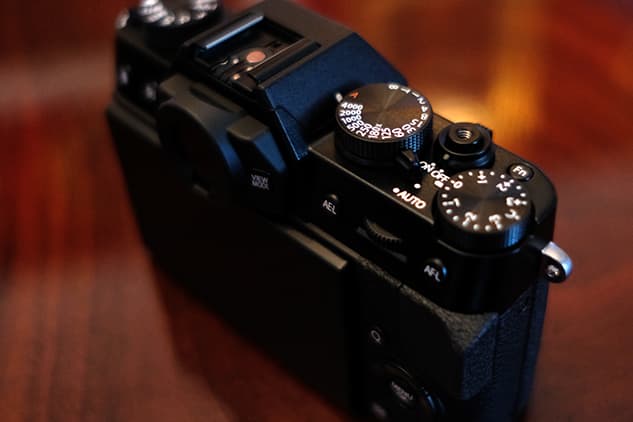
A new customisable function button replaces what was the movie record button on the X-T10
Other features include built-in Wi-fi, Full HD and 4K video (100Mbps), a silent electronic shutter capable of exposures up to 1/32,000sec, digital split screen focus assist as well as the full suite of film simulation modes that can now be used when shooting stills and recording video.
Design & Handling
The design of the X-T20 bears all the hallmarks of its predecessor. The top and base plates are made of lightweight magnesium alloy to give it a solid and robust feel in the hand, and in typical Fujifilm fashion the body is based around traditional analogue controls, with top-plate shutter speed and aperture dials complemented by an aperture ring on most Fujinon lenses.
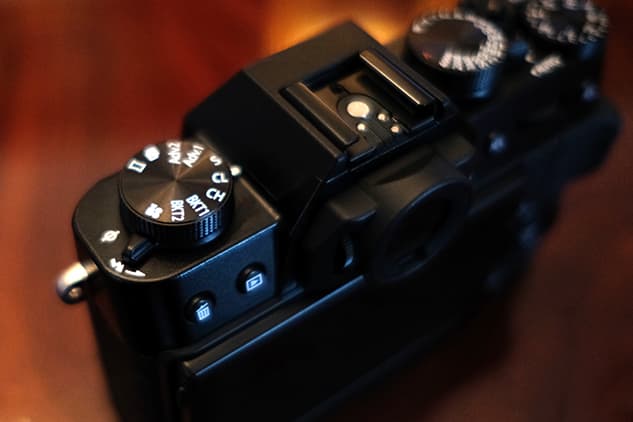
Movie recording is now accessed via the drive mode dial. Note the switch offset from the drive dial that’s used to raise the X-T20’s pop up flash
There’s no ISO dial like you get on the X-T2 and you’ll find a customisable function button takes the place of where the movie record button was on the X-T10. The drive dial on the top plate now has a video position to switch between still and video recording, and the exposure compensation dial also has a new ‘C’ position to enable compensation of up to +/-5EV in 1/3 steps using the front command dial.
In all other respects of its much the same as the X-T10 and continues to cater for both beginners and more experienced photographers alike with its top-plate mode switch beside the shutter speed dial that’s used to toggle between Auto and manual exposure modes.
First Impressions
With the X-T10, Fujifilm struck a perfect blend between what enthusiasts were after from an SLR-style camera with an electronic viewfinder. It arrived at a very competitive price point that fitted many peoples budgets. In an effort to go one better, Fujifilm has implemented their latest sensor and processor technology, reworked the autofocus system, introduced 4K video, added a touchscreen and applied subtle refinements to the position of some controls.
As you might expect, all this comes with a higher price, but with £300 being the difference between this latest model and the cost of the X-T10 at the time of launch, the X-T20 is a harder pill to swallow. The body only price difference between the X-T20 and the X-T2 currently stands at £600.
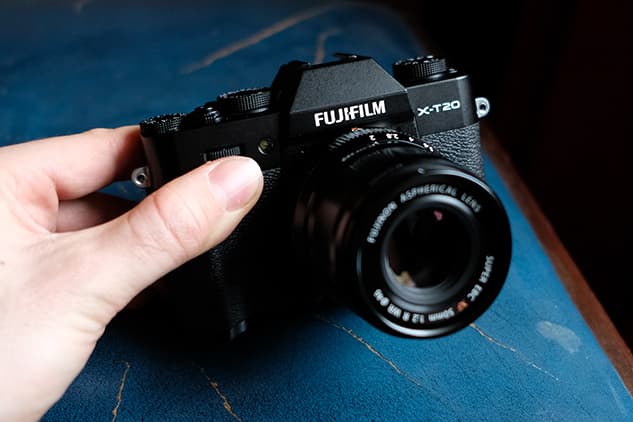
The X-T20 feels noticeably smaller in the hand when you compare it to the feel of the X-T2
From our hands-on experience with the X-T20, we got the sense it has come on quite a way from the X-T10. It feels more responsive and better equipped for shooting fast paced subjects in challenging situations where time is of the essence. Having the touch screen to shift the AF point around the frame and review images in playback mode is helpful, but it can also be disabled should you like to control the camera more conventionally using its buttons. We didn’t foresee Fujifilm employing the AF-C custom settings into their junior X-T series model quite so soon, however this is good news for those already shooting with an X-T2, who might possibly look at the X-T20 as a backup body.
Overall, the X-T20 has many of the advanced features that today’s novice and aspiring enthusiasts desire without stepping too closely on the X-T2 toes. For those whose budget can’t quite stretch to an X-T2, the X-T20 looks set to be the next best thing and it certainly seems to have the potential to perform well in a wide range of situations. We hope it won’t be too long before we’re putting a review sample through its paces.







